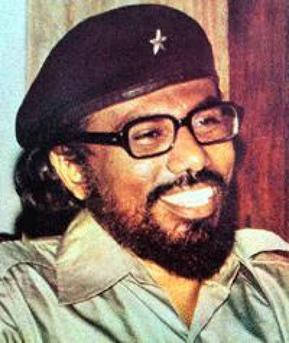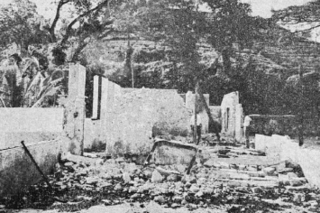Related Research Articles

The history of Sri Lanka is unique because its relevance and richness extend beyond the areas of South Asia, Southeast Asia and the Indian Ocean. The early human remains which were found on the island of Sri Lanka date back to about 38,000 years ago.

Mahinda Rajapaksa is a Sri Lankan politician. He served as the President of Sri Lanka from 2005 to 2015; the Prime Minister of Sri Lanka from 2004 to 2005, 2018, and 2019 to 2022; the Leader of the Opposition from 2002 to 2004 and 2018 to 2019, and the Minister of Finance from 2005 to 2015 and 2019 to 2021. He has been a Member of Parliament (MP) for Kurunegala since 2015.

Janatha Vimukthi Peramuna is a Marxist–Leninist communist party in Sri Lanka. The party was formerly a revolutionary movement and was involved in two armed uprisings against the government of Sri Lanka: once in 1971 (SLFP), and another in 1987–89 (UNP). The motive for both uprisings was to establish a socialist state.

Patabendi Don Jinadasa Nandasiri Wijeweera, better known as Rohana Wijeweera, was a Sri Lankan Marxist political activist, revolutionary and the founder of the Janatha Vimukthi Peramuna. Wijeweera led the party in two unsuccessful insurrections in Sri Lanka, in 1971 and 1987 to 1989.
The United People's Freedom Alliance was a political alliance in Sri Lanka founded by former Sri Lankan president Chandrika Kumaratunga in 2004 and dissolved by former Sri Lankan President Maithripala Sirisena in 2019.

The 1971 Janatha Vimukthi Peramuna (JVP) insurrection was the first of two unsuccessful armed revolts conducted by the communist Janatha Vimukthi Peramuna (JVP) against the socialist United Front Government of Sri Lanka under Prime Minister Sirimavo Bandaranaike. The revolt began on 5 April 1971 and lasted until June of that year. The insurgents held towns and rural areas for several weeks, until the regions were recaptured by the armed forces, following strong support from friendly nations that sent men and material. Although this first attempt to seize power was quickly crushed by force, in 1987 the JVP launched a low-intensity insurgency in the island's southern, central and western regions that lasted several years.

The 1987–1989 JVP insurrection, also known as the 1988–1989 revolt or the JVP troubles, was an armed revolt in Sri Lanka, led by the Marxist–Leninist Janatha Vimukthi Peramuna, against the Government of Sri Lanka. The insurrection, like the previous one in 1971, was unsuccessful. The main phase of the insurrection was a low-intensity conflict that lasted from April 1987 to December 1989. The insurgents led by the JVP resorted to subversion, assassinations, raids, and attacks on military and civilian targets while the Sri Lankan government reacted through counter-insurgency operations to suppress the revolt.
Human rights in Sri Lanka provides for fundamental rights in the country. The Sri Lanka Constitution states that every person is entitled to freedom of thought, conscience and religion, including the freedom to have or to adopt a religion or belief of his choice. And, that every person is equal before the law.

The Sri Lankan state has been accused of state terrorism against the Tamil minority as well as the Sinhalese majority, during the two Marxist–Leninist insurrections. The Sri Lankan government and the Sri Lankan Armed Forces have been charged with massacres, indiscriminate shelling and bombing, extrajudicial killings, rape, torture, disappearance, arbitrary detention, forced displacement and economic blockade. According to Amnesty International, state terror was institutionalized into Sri Lanka's laws, government and society.
The Sooriyakanda mass grave is the mass burial ground of murdered school children from Embilipitiya Maha Vidyalaya in Sri Lanka. These school children were killed and buried as part of the counterinsurgency during the second JVP uprising in Sri Lanka. It was alleged that over 300 bodies were buried in the location. The mass grave was located in 1994. The Sri Lankan government last reported in 1996 to have conducted a forensic analysis of the burial ground uncovering an unspecified number of bodies. Local media, NGOs and the US state department have claimed that the investigations are not satisfactory.

Nandasena Gotabaya Rajapaksa, is a former Sri Lankan politician and military officer, who served as the eighth President of Sri Lanka from 18 November 2019 until his resignation on 14 July 2022. He previously served as Secretary to the Ministry of Defence and Urban Development from 2005 to 2015 under the administration of his elder brother former President Mahinda Rajapaksa, during the final phase of the Sri Lankan Civil War.
Tens of thousands of people have been disappeared in Sri Lanka since the 1980s. A 1999 study by the United Nations found that Sri Lanka had the second highest number of disappearances in the world and that 12,000 Sri Lankans had disappeared after being detained by the Sri Lankan security forces. A few years earlier the Sri Lankan government had estimated that 17,000 people had disappeared. In 2003 the Red Cross stated that it had received 20,000 complaints of disappearances during the Sri Lankan Civil War of which 9,000 had been resolved but the remaining 11,000 were still being investigated. Amnesty International reported in 2017 that the disappeared persons in Sri Lanka could be between 60,000 and 100,000 since the late 1980s.

The history of Sri Lanka from 1948 to the present is marked by the independence of the country through to Dominion and becoming a Republic. Currently, there is a peaceful situation in Sri Lanka and the country is being run very well. The civil war in Sri Lanka ended in 2009 and there is no problem between the Sinhalese and Tamil people of Sri Lanka and they live in harmony. Sri Lanka's independence in 1948 made Sri Lanka the prosperous state it is today.
Hambantota electoral district is one of the 22 multi-member electoral districts of Sri Lanka created by the 1978 Constitution of Sri Lanka. The district is conterminous with the administrative district of Hambantota in the Southern province. The district currently elects 7 of the 225 members of the Sri Lankan Parliament and had 421,186 registered electors in 2010.

Lakshman Namal Rajapaksa is a Sri Lankan politician and lawyer. He is the eldest son of Sri Lankan former President and former Prime Minister Mahinda Rajapaksa and a member of parliament. He was the Minister of Youth and Sports from 2020 to 2022.
General Shavendra Silva, is a Sri Lanka Army four star general who is the current Chief of Defence Staff, the head of the Sri Lanka Armed Forces serving from 1 January 2020. He also served as the Commander of the Sri Lanka Army from 19 August 2019 to 31 May 2022. His other important appointments include, Chief of Staff of the army, Adjutant General and Director of Operations of the Army. During the Sri Lankan civil war he gained fame as the General Officer Commanding of the elite 58 Division. He had also served as the Deputy Permanent Representative to the United Nations Headquarters.
The Mannar mass grave, discovered in 2013, is located in Mannar, Sri Lanka.
Terrorism in Sri Lanka has been a highly destructive phenomenon during the 20th and 21st centuries, especially so during the periods of the Sri Lankan Civil War (1983–2009) and the first (1971) and second JVP insurrections (1987–1989). A common definition of terrorism is the systematic or threatened use of violence to intimidate a population or government for political, religious, or ideological goals. Sri Lanka is a country that has experienced some of the worst known acts of modern terrorism, such as suicide bombings, massacres of civilians and assassination of political and social leaders. Terrorism has posed a significant threat to the society, economy and development of the country. The Prevention of Terrorism Act of 1978 is the legislation that provides the powers to law enforcement officers to deal with issues related to terrorism in Sri Lanka. It was first enacted as a temporary law in 1979 under the presidency of J. R. Jayewardene, and later made permanent in 1982.
The Batalanda detention centre was an alleged detention centre located within the Batalanda Housing Scheme of the State Fertiliser Corporation in the village of Butalanda, situated in the Biyagama Electorate. It was used by the Counter Subversive Unit of the Sri Lanka Police during the 1987–89 JVP insurrection to detain persons who were linked to or suspected to have links to the Janatha Vimukthi Peramuna (JVP), as part of the counterinsurgency campaign launched by the United National Party (UNP) government led by President Ranasinghe Premadasa.
Pramitha Bandara Tennakoon is a Sri Lankan politician, former Cabinet Minister, former provincial minister and Member of Parliament. He served as the Minister of Ports and Shipping in the Cabinet of President Gotabaya Rajapaksa.
References
- ↑ "Matale mass grave traced to 1987-89". Island. 21 January 2013. Retrieved 9 April 2013.
- ↑ "JVP says Matale mass grave has remains of 200 torture victims". Island. 5 February 201. Retrieved 9 April 2013.
- ↑ "Sri Lanka Matale mass grave 'dates from late 1980s'". BBC. 28 March 2013. Retrieved 9 April 2013.
- ↑ "Leading archaeologist calls for accountability on Matale mass grave". JDS. 30 March 2013. Retrieved 9 April 2013.
- ↑ Anna Niestat (2008). Recurring Nightmare: State Responsibility for "disappearances" and Abductions in Sri Lanka. Human Rights Watch. pp. 19–. GGKEY:UXWF05XJ0X5. Retrieved 10 April 2013.
- ↑ "Sri Lanka mass grave dates to Marxist rebellion, says judge". The Guardian. 28 March 2013. Retrieved 10 April 2013.
- ↑ "Sri Lanka Matale 'mass grave could be a crime site'". BBC. 14 December 2012. Retrieved 11 April 2013.
- ↑ Metta Spencer (1998). Separatism: democracy and disintegration. Rowman & Littlefield. pp. 263–. ISBN 978-0-8476-8585-1 . Retrieved 10 April 2013.
- ↑ Margaret Lock; Mark Nichter (20 May 2004). New Horizons in Medical Anthropology: Essays in Honour of Charles Leslie. Routledge. pp. 287–. ISBN 978-0-203-39851-7 . Retrieved 10 April 2013.
- ↑ "Rajapaksa Govt Haunted By Ghosts From The Past". The Sunday Leader. Retrieved 10 April 2013.
- ↑ "Matale Mass Grave". www.srilankabrief.org. 3 April 2013. Archived from the original on 7 November 2013. Retrieved 10 April 2013.
- ↑ "Is this presidential commission on Matale mass grave worth its salt?". Ceylon Today. Retrieved 10 April 2013.
- ↑ "Sri Lanka to probe mass grave with more than 150 dead". /news.yahoo.com. 7 April 2013. Retrieved 10 April 2013.
- ↑ "Gotabaya the prime suspect in Matale mass killings now begins his evidence killing operations –Orders destruction of police records". lankaenews.com. 8 April 2013. Archived from the original on 18 April 2013. Retrieved 10 April 2013.
